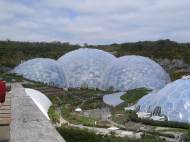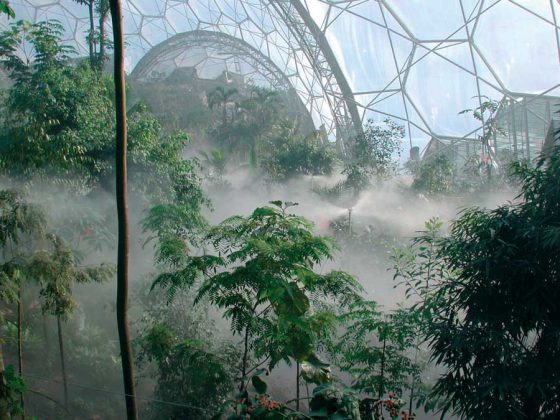Green architecture – Eden Project in UK
 In this article we’re going to write about green architecture which serves nature’s variety. Eden Project is a greenhouse located in Cornwall, United Kingdom, which attracts loads of people. Inside the greenhouse there are several artificial biomes where they grow plants collected from all around the world. The Eden Project is constructed in an unused china clay pit. Once into the attraction, there is a meandering path with views of the two closed biomes, planted landscapes, including vegetable gardens and many sculptures.
In this article we’re going to write about green architecture which serves nature’s variety. Eden Project is a greenhouse located in Cornwall, United Kingdom, which attracts loads of people. Inside the greenhouse there are several artificial biomes where they grow plants collected from all around the world. The Eden Project is constructed in an unused china clay pit. Once into the attraction, there is a meandering path with views of the two closed biomes, planted landscapes, including vegetable gardens and many sculptures.
The complex comprises a number of domes that house plant species from around the world, each dome emulating a natural biome. The domes are made out of hundreds of hexagons and a few pentagons that connect the whole construction. The Rainforest Biome, which is the largest greenhouse in the world, covers 1.559 hectares (3.9 acres) and it’s 55m high, 100m wide and 200m long. It is used for tropical plants, such as fruiting banana trees, coffee, rubber and giant bamboo, and is kept at a tropical temperature. The Mediterranean Biome covers 0.654 hectares (1.6 acres) and it’s 35m high, 65m wide and 135m long. It houses familiar warm temperate and arid plants such as olives and grape vines and various sculptures. The Outdoor Biome (which is not covered) represents the temperate regions of the world with plants such as tea, lavender, hops, hemp and sunflowers.
The Core is an addition to the site opened in September 2005. It provides the Eden Project with an education facility, incorporating classrooms and exhibition spaces designed to help communicate Eden’s central message about the relationship between people and plants. Accordingly, the building has taken its inspiration from plants, most noticeably in the form of the soaring timber roof, which gives the building its distinctive shape.
As the plants the domes are hosting are growing, so is the Eden Project. Their new aspiration is the creation of a third closed dome named Edge. That dome should contain desert plants. Besides being a botanic garden, the space is additionally used to host concerts and other entertainment events. You can see the upcoming events at this page on their website. They are also running a few green programs as generating power and waste management programs.
Besides the greener ways they get the needed power, and the awarded Waste Neutral program, the Eden Project people are working on a idea of creating the UK’s first geothermal plant that would use heat from granite outcrops beneath the Earth’s surface. Initially the plant would be used to supply the Eden Project in Cornwall but could potentially feed spare carbon-neutral electricity into the National Grid.
Eden and its commercial partner claim, EGS Energy, believe this is the first in a series of projects that could lead to Cornwall’s “hot rocks” supplying up to one-tenth of the UK’s electricity.
Matt Hastings, Eden’s energy manager, said: “It’s a massively exciting project – a way of making sure Eden has a source of green power but also of feeding heat and power into the local community and into the National Grid. We will only need a quarter or a fifth of the electricity that will be generated. Cornwall leads the way in wind and wave energy technology. Now we’re trying to do the same in geothermal power.”
Water will be pumped into an injection hole and then allowed to percolate through the hot rocks and heat up. The water will then be pumped back out through a second hole, returning to the surface at around 150C. The heated water will be converted into electricity via a heat exchanger.
The remaining heat in the water can be used to heat local buildings, hopefully not just at Eden but in surrounding areas. Spare heat could be used by Eden for growing exotic fruit and vegetables out of season or possibly in a spa. It is estimated that the plant, which could be ready by 2012, could generate enough electricity to supply the equivalent of almost 5,000 homes.
A spokesman said: “The energy would be 100% controllable and on an industrial scale. Above all, compared to other clean technologies, it has a small footprint above ground, and since it consists of a closed loop system its potential negative environmental impact is small.”










Absolutely stunning.
Beautiful. One question permeates with all these new structures. Why are we still trying to centralize the power grid? Why are we not building stand alone(self powered) homes?????? Only when we decentralize the power grid….I’ll dare to call it progress. Don’t be fooled, this is not free energy for the population.